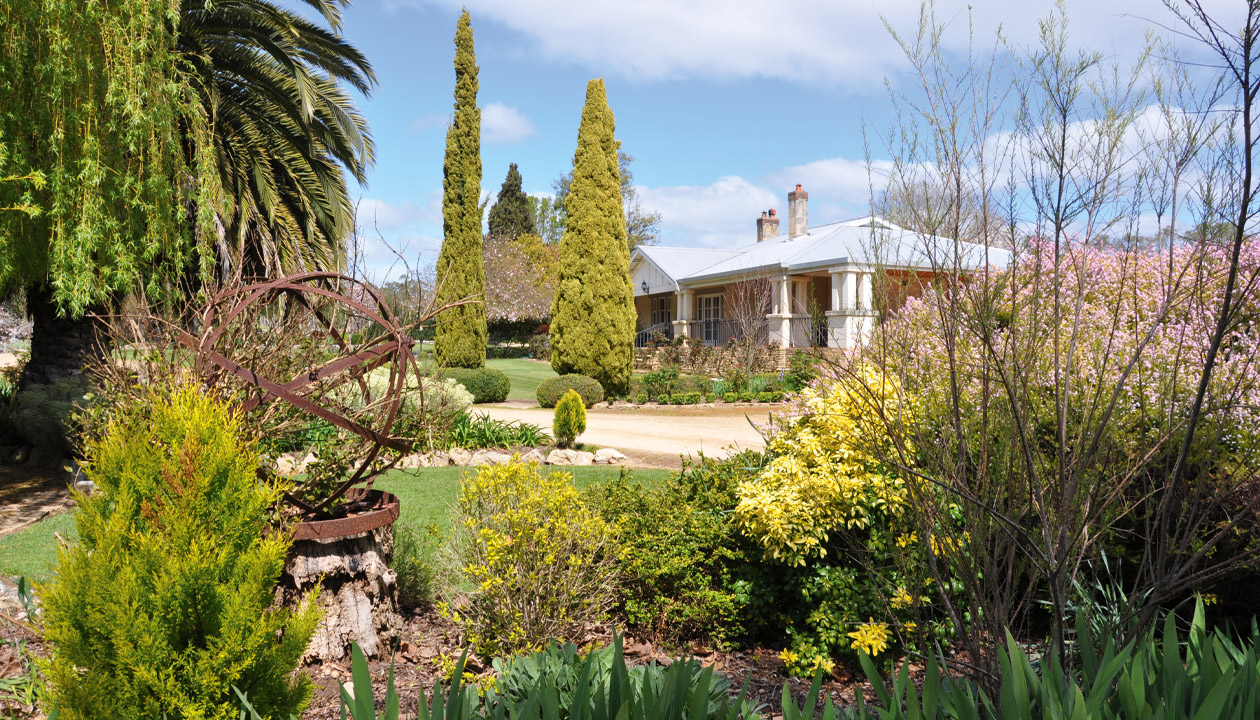The sublime St Mary’s Garden wows visitors to the Mulligans’ cellar door.
Story + Photos Gretel Sneath
A long, dusty lane dissects Coonawarra’s famous terra rossa strip of red earth in eastern SA, and right at the end, beyond the vines, paddocks and pines, Glenys and Barry Mulligan’s magnificent garden greets unsuspecting visitors to their family-owned cellar door. “You come out of the trees and along the bare road, and then you arrive,” Glenys says. “Oasis is the common word used.”
St Mary’s Garden has been more than 70 years in the making and, like the region’s prized cabernet, it just gets better with age. Established trees, conifers and hundreds of roses entice guests to wander and dream – invariably with wine glass in hand.
When the property was purchased by Barry’s father in the late 1930s, the elevated limestone ridge that rose above the surrounding plain reminded him of the spectacular summit St Mary Peak, which shadowed his childhood home in the Flinders Ranges. “We’ve got the highest point in the district, offering 360-degree views of the Limestone Coast,” Barry says.
Approximately 120ha of the property remains untouched: a wilderness sanctuary containing pre-European vegetation that attracts up to 150 different species of birds, including red-tailed black cockatoos. “It’s a microcosm of all the different landforms in the Penola-Coonawarra district – from tea-tree flats to terra rossa ridges, classic red gum-lined waterholes and stringybark dune systems; it’s all in there,” Barry says.
Closer to home, the fertile red earth has given rise to a 26ha vineyard and almost 2ha of garden. “Terra rossa soil is great for growing grapes, but it’s also fantastic for growing roses,” Glenys says. “The Mediterranean climate also helps – we get around 600ml of rainfall a year.”
Barry’s mother planted the first rose bush back in the 1940s, a Lorraine Lee that still blooms today. Glenys has added at least 500 more, for they thrive in the alkaline soils. Tightly clipped balls of coastal rosemary, English and Japanese box, teucrium, lavender and pittosporum ‘golf balls’ add structure with their silvery hues, interspersed with strappy plants, succulents, agapanthus and sun-loving echiums. “I do like texture in the garden, and I like the colours to harmonise to a certain degree,” Glenys says. “In spring, we first get the jonquils, then the daffodils, then the tulips and the Dutch iris, then the blossoms seem to take it in turns.”
Tucked behind a tall cypress hedge in a cluster of modified rainwater tanks, there are strong signs that a bumper strawberry crop is also on its way, while heirloom tomatoes will soon begin scaling steel hoops salvaged from oak wine barrels. There is abundance in every corner of the garden, yet it was a vastly different scene two years ago, after a mini-tornado tore through the property and claimed some of the oldest trees. “It was like pick-up sticks; in all my life, I’ve never seen anything like it,” Barry says. The subsequent clean-up opened up the views to the vineyard. “The trees that we lost were 70-odd years old, and we decided to look forward and plant for the next 70 years rather than dwell too much on the losses.”
Son Robin, the youngest of Barry and Glenys’s six adult children, designed an imposing amphora to fill one of the gaps. Sculptor Ivo Tadic carved it from local limestone, with Barry constructing the stone plinth it rests upon. “It filled a hole in the garden and it filled a hole in the continuum, representing the last 70 years and the next 70 years. You’ve got to have a touchpoint every now and then,” Barry says.
The sculpture certainly catches the eye, but perhaps the most distinctive feature of all is the 2km-plus network of dry-stone walls that separates the garden from the vineyard and paddocks. (The Mulligans also farm cattle and breed first-cross Merino ewes.) The walls started off as a by-product of the first vineyard plantings, when the stony paddocks were ploughed in 1985, and have become an ongoing labour of love for Barry, Glenys, Robin and his brother Ian. “We all have our own style – I do the pernickety fiddly stuff, as I’m a frustrated engineer, and Glenys, Robin and Ian do their own thing, but there’s a synchronicity in what we do and it all fits together and is very satisfying,” Barry says.
A commercial quarry that has operated on the property since the 1960s feeds their addiction. Filled with endless supplies of limestone and sandstone in different shapes and sizes, Barry calls it the IGA (supermarket) of rock. “Some of it is quite lumpy, but you also have areas of this beautiful book-leaf flat stone that comes up behind the bulldozers, and it’s absolutely magic,” he says.
“We call it nature’s Lego,” Glenys says. “If you use your imagination, there’s no limit to what you can create, and it’s likely that they’ll still be here in hundreds of years.”
The garden is open for viewing 10am–4pm daily, except Good Friday and Christmas Day.
This story excerpt is from Issue #128
Outback Magazine: Dec/Jan 2020










